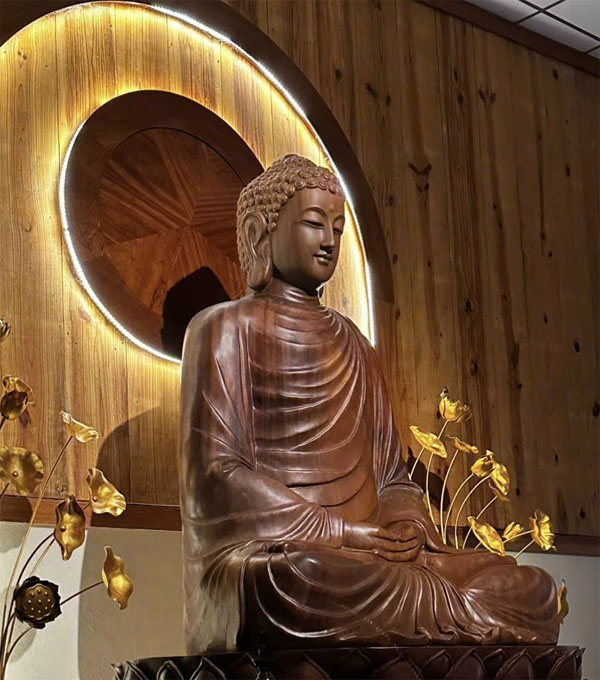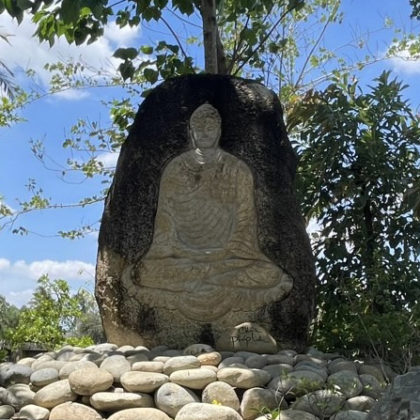Gautama, The Buddha
The Founder of Buddhism.
Gautama Buddha, the founder of what came to be known as Budddhism, lived in Northern India in the 6th century B.C. His personal name was Siddhattha, and family name Gotama. The name “Buddha” was given to Him after He attained Enlightenment and realized the Truth. It means the ‘Awakened’ or the ‘Enlightened One’. He generall called Himself the Tathagata, while His followers called Him Bhagava, the Blessed One. Others spoke of Him as Gotama or Sakyamuni.
He was born a prince who seemed to have everything. He had a luxurious upbringing and His family was of pure descent on both sides. He was the heir to the throne, extremely handsome, inspiring trust, stately and gifted with great beauty of complexion and fine present. At sixteen He married His cousin named Yasodhara who bore Him a son whom they called Rahula. His wife was majestic, cheerful day and night, and full of dignity and grace.
Despite all this, He felt trapped amidst the luxury like a bird in a golden cage. During a visit to the city one day, He saw what is known as the ‘Four Sights’, that is, an old man, a sick man, a dead man, and a holy recluse. When He saw the sights, one after another, the realization came to Him that, ‘Life is subject to age and death’. He asked, ‘Where is the realm of life in which there is neither age nor death?’ The sight of the recluse, who was calm for having given up the craving for material life, gave Him the clue that the first step in His search for Truth was Renunciation.
Determined to find the way out of these universal sufferings, He decided to leave home to find the cure not for Him only, but for all mankind. One night in His twenty-ninth years, He bade His sleeping wife and son a silent farewell, saddled His great while horse, and role off toward the forest.
His renunciation is unprecedented in history. He left at the height of youth, from pleasures to difficulties; from certainty of material security to uncertainty; from a position of wealth and power to that of a wandering ascetic who took shelter in the cave and forest, with His ragged robe as the only protection against the blazing sun, rain and winter winds. He renounced His position, wealth, promise of prestige and power, and a life filled with love and hope in exchange for the search for Truth which no one had found.

For six long years, He laboured to find the Truth. He studied under the foremost masters of the day, and learned all these religious teachers could teach Him. When He could not find what He was looking for, He joined a band of ascetics and tortured His body so as to break its power and crush its interference, since it was believed that Truth could be found this way. A man of enormous energy and will power, He outdid other ascetics in every austerity they proposed. While fasting, He ate so little that when He took hold of the skin of His stomach, He actually touched His spine. He pushed Himself to the extent that no man had done and yet lived: He, too, would have certainly died had He not realised the futility of self mortification, and decided to practise moderation instead.
On the full moon night of the month of Vesakha, He sat under the Bodhi tree at Gaya, wrapped in deep meditation. It was then that His mind burst the buddle of the universe and realised the true nature of all life and all things. At the age of 35 years, He was transformed from an earnest truth seeker into the Buddha, the Enlightened One.
For nearly half a century, the Buddha walked on the dusty paths of India teaching the Dhamma so that those who heard and practised could be ennobled and free. He founded an order of monks and nuns, challenged the caste system, raised the status of women, taught religious freedom and free inquiry, opened the gates of deliverance to all, in every condition of live, hight or low, saint or sinner, and ennobled the lives of criminals like Angulimala and courtesans like Ambapali.
He was towering in wisdom and intellect. Every problem was analysed in component parts and then reassembled in logical order with the meaning made clear. None could defeat Him in dialogue. An unequalled teacher, He still is the foremost analyst of the mind and phenomena even up to the present day. For the first time in history, He gave men the power to think for themselves, raised the worth of mankind, and showed that man can reach to the highest knowledge and supreme Enlightenment by his own efforts.
Despite His peerless wisdom and royal lineage, He was never removed from the simple villagers. Surface distinctions of class and caste meant little to Him. No one was too or low for Him to help. Often when an outcaste, or poor and dejected came to Him, his self-respect was restored and he turned from the ignoble life to that of a noble being.
The Buddha was full of compassion (karuna) and wisdom (panna), knowing how and what to teach each individual for his own benefit according to his level and capabilities. He was known to have walked long distances to help one single person.
He was affectionate and devoted to His disciples, always inquiring after their well-being and progress. When staying at the monastery, He paid daily visits to the sick wards. His compassion for the sick can be seen from His advice: ‘He who attends the sick, attends on me’. The Buddha kept order and discipline on the basis of mutual respect. King Pasenadi could not understand how the Buddha maintained such order and discipline in the community of monks, when he as a king with the power to punish, could not maintain it as well in his court.
Many miraculous powers were attributed to Him, but He did not consider these important. To Him, the greatest miracle was to explain the Truth and make a man realise it. A teacher with deep compassion, He was moved by human suffering and determined to free men from its fetters by a rational system of thought and way of life.
The Buddha did not claim to have ‘created’ worldly conditions, universal phenomena, or the Universal Law which we call the ‘Dhamma”. Although described as lokavidu or ‘knower of the worlds’, He was not regarded as the sole custodian of that Universal Law. He freely acknowleged that the Dhamma, together with the working of the cosmos, is timeless; it has no creator and is independent in the absolute sense. Every conditioned thing that exists in the cosmos is subject to the operation of Dhamma. What the Buddha did (like all the other Buddhas before Him) was to rediscover this infallible Truth and make it known to mankind. In discovering the Truth, He also found the means whereby one could ultimately free oneself from being subjected to the endless cycle of conditioning, with its attendant evils of unsatisfactoriness.
After forty-five years of ministry, the Buddha passed away at the age of eighty at Kusinara, leaving behind thousands of followers, monks and nuns, and a vast treasure store of Dhamma Teaching. The impact of His great love and dedication is still felt today.
Source: What Buddhists Believe, K. Sri Dhammananda


